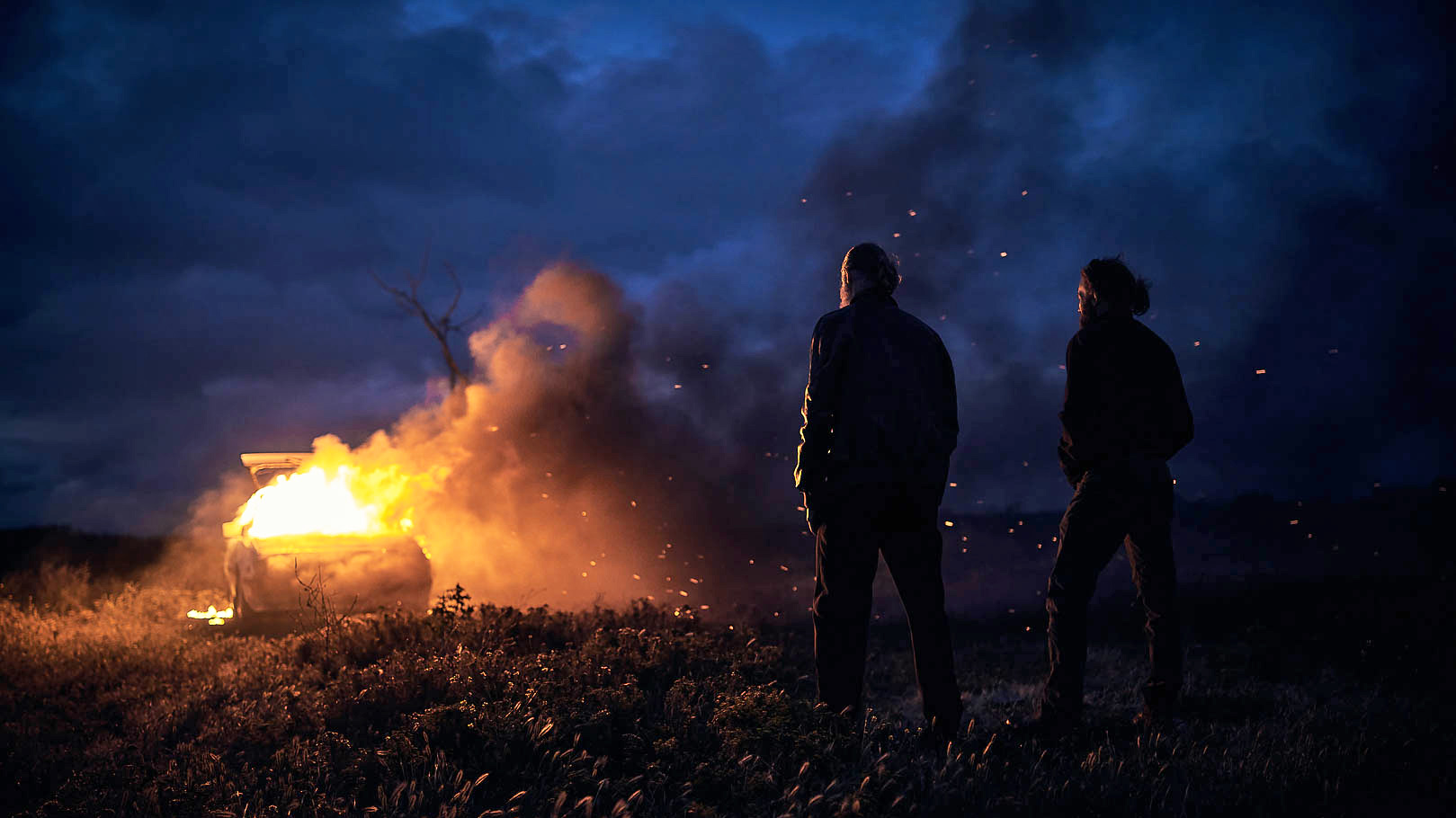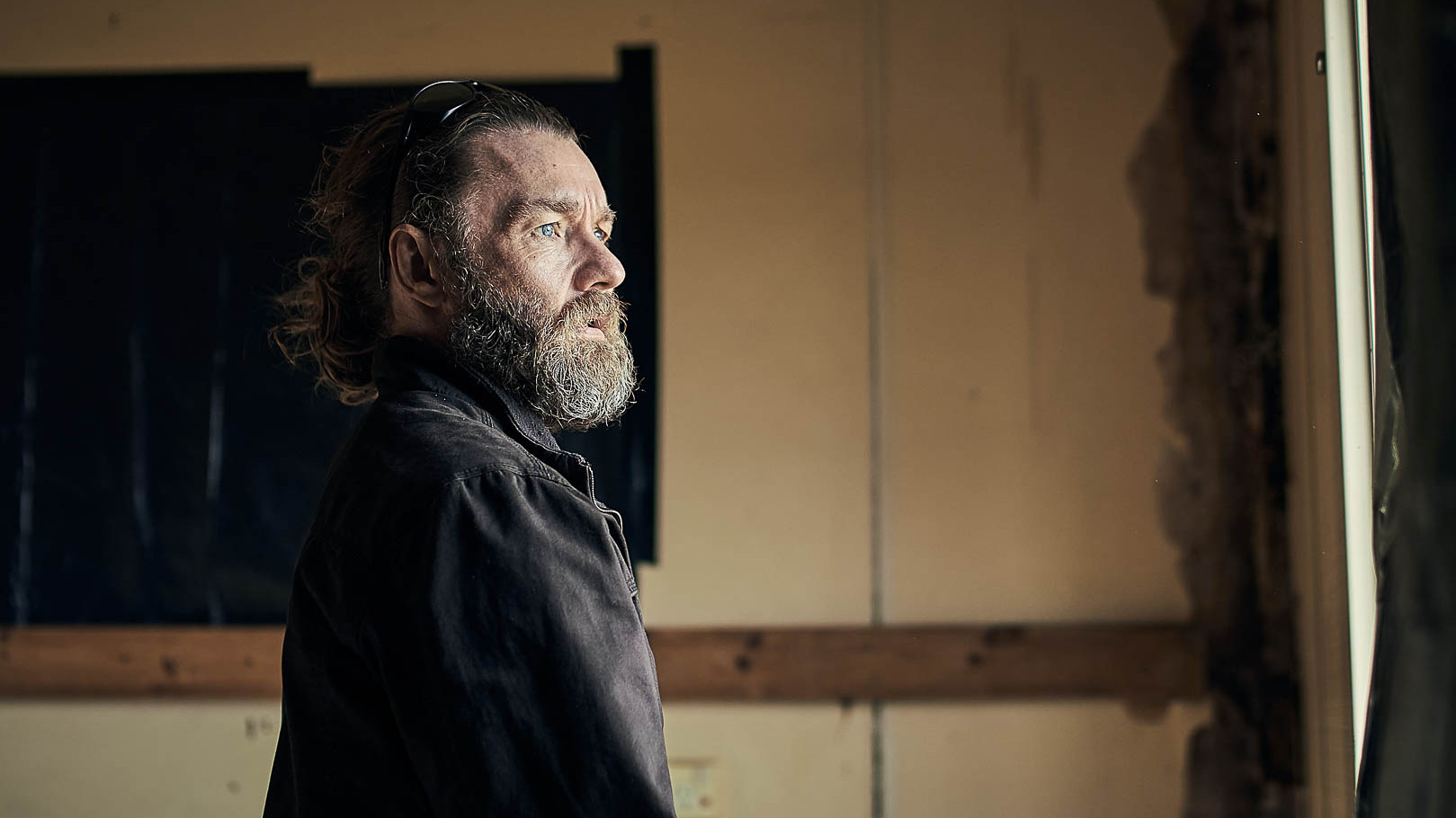The Australian Ugliness: Thomas M. Wright’s The Stranger

Critics Campus 2022 participant Andrew Fraser unravels the ethical tightrope trod by Thomas M. Wright’s The Stranger and male-focused true-crime films of its ilk.
For filmmakers, the darkest corners of the human mind are rich territory for creative provocation. For victims of crime, the darkness of trauma is not a costume to try on – it’s just an empty space.
Informed by the true-crime book The Sting by Kate Kyriacou, The Stranger is the sophomore film from writer/director Thomas M. Wright, following his striking debut Acute Misfortune (MIFF Premiere Fund 2018). Like Wright’s first film, The Stranger tells the story of two men brought together by design. Mark (Joel Edgerton), masquerading as an ex-con, has been tasked with luring Henry (Sean Harris) into joining a blue-collar crime organisation. Unbeknown to Henry, the group is exclusively populated with other undercover detectives. Mark must gain Henry’s trust to extract a confession of guilt, as he is the prime suspect for the abduction and murder of an unnamed child. Henry is entranced by the group’s promise to grant him a new lease on life, with the condition that he be transparent about his sordid past. As Henry is brought closer into the organisation’s trap, Mark feels his psyche unspool, becoming knotted in Henry’s poisonous web.
As an exercise in craft, The Stranger is in unquestionably good form. Wright imbues the film with an unmistakable sense of dread, assisted by Oliver Coates’s frayed score and the Lynchian sound design, elevating the film far above the standard police procedural. The two leads excel: Harris, sporting a fine Australian accent, is all twisted restraint as the personification of venality, his haunting, crystalline features amplified by the deep shadows of Sam Chiplin’s cinematography. Edgerton is torturously stoic as Mark, mirroring Henry via a clever doubling effect in the pair’s matching styling. Mark is an unknowable figure, engulfed in a performance of masculinity like a misguided method actor.
Questions of performativity are central to The Stranger, and the film routinely asks us to question the true nature of an individual, and whether there is a distinction between the real and the performed self. The police sting is much like an extended acting exercise – an ethically dubious one at that. This tactic, known as a ‘Mr Big’ operation, is banned in many countries due to the high risk of operations resulting in a false confession. But those in favour of the technique argue that it is a necessary evil to catch a killer.
Given the high sensitivity levels around this policing method, and the criminal case that inspired The Stranger, the filmmakers have been called on to justify the value of this particular story beyond their artistic ambition. There is great risk in dramatising true crime, as the lines between truth and fiction are blurred, with new questions drawn out of the film’s interpretation of the event, rather than the event itself. This is perhaps the appeal of these stories for artists in a country that’s constantly reckoning not only with its colonial myths but also with the truth of its dark past.
In an introduction for his film, Wright suggested that, for him, The Stranger is an exhumation of our nation’s bloodthirsty history and how this blood runs in the actions of men generations later. The film routinely returns to Australia’s natural landscape, most unnervingly to the site where the real-life victim’s remains were discovered. This, coupled with the intensity of the police investigation at the story’s centre, enforces how little attention has been paid to the plight of Indigenous children at the hands of white authority. In the film’s most emotional scene, a fellow detective, Rylett (an excellent Jada Alberts), movingly relays the details of another child’s death, acknowledging the generations of Australian children who were robbed of their childhoods through racially discriminatory government interference – or, in the missing child’s case, death in cold blood.

The Stranger
The film trusts the audience to draw these comparisons, but one must apply this reading externally, as this thematic thread is not explicit. Wright is not interested in didacticism, which is to his credit, but it’s difficult to assess whether international audiences would be able to make these cultural connections without an understanding of Australia’s marred history.
Wright clearly has great empathy for the family of the real-life victim, which he conveys in his decision to cast his own son (Cormac Wright) as the child of Edgerton’s cop, adding a personal stake to the picture. However, the inclusion of this parallel child muddles the film’s focus, especially as the filmmakers were adamant in their decision to remove any visual representation of the murder of the unnamed child. The film seems to realise the police case is not as emotionally involving without the vivid knowledge of the deceased child, but does the audience really require a visual representation of a child to understand that violence toward a child is wrong? Wright’s emotional identification with the material as auteur/parent becomes centralised in a way that overpowers the nameless victim at the film’s axis, in favour of the meta element present in the father–son dynamic. In an attempt to respect the victim’s family, the deceased is rendered invisible in their own story.
Like Romper Stomper (1992), Snowtown (2011) and Nitram (MIFF Premiere Fund 2021) before it, The Stranger dedicates its runtime to ruminating on the psychology of men on society’s fringes. But even when these portrayals are compelling, as the film often is, the persistent desire to understand these men seems to stall at meditation, rather than truly interrogating how the culture can move past this Australian ugliness. The world’s first full-length film, the 1906 Australian production The Story of the Kelly Gang, was concerned with the legend of the ‘wild colonial boy’ and, over a hundred years later, there are few Australian works that push our filmic imagination beyond this over-investment in what motivates a tortured male psychopath. There is an untapped need for complex and psychologically rigorous portrayals of men that should not require the protagonist to be an infamous criminal. And while The Stranger differentiates itself by being about the aftermath of a crime, rather than the path towards depravity, the overabundance of these films in a local film industry, and the dominance of the true-crime genre in general, can’t help but lead to fatigue.
Audiences can choose whether or not to engage with these films. This is not the same for victims of crime. There is no closure or finality when a film cuts to black. The Stranger is a commendable film in its willingness to face the horrors of male violence head-on, but it’s one that struggles to add anything further to the conversation on the value of true-crime films.